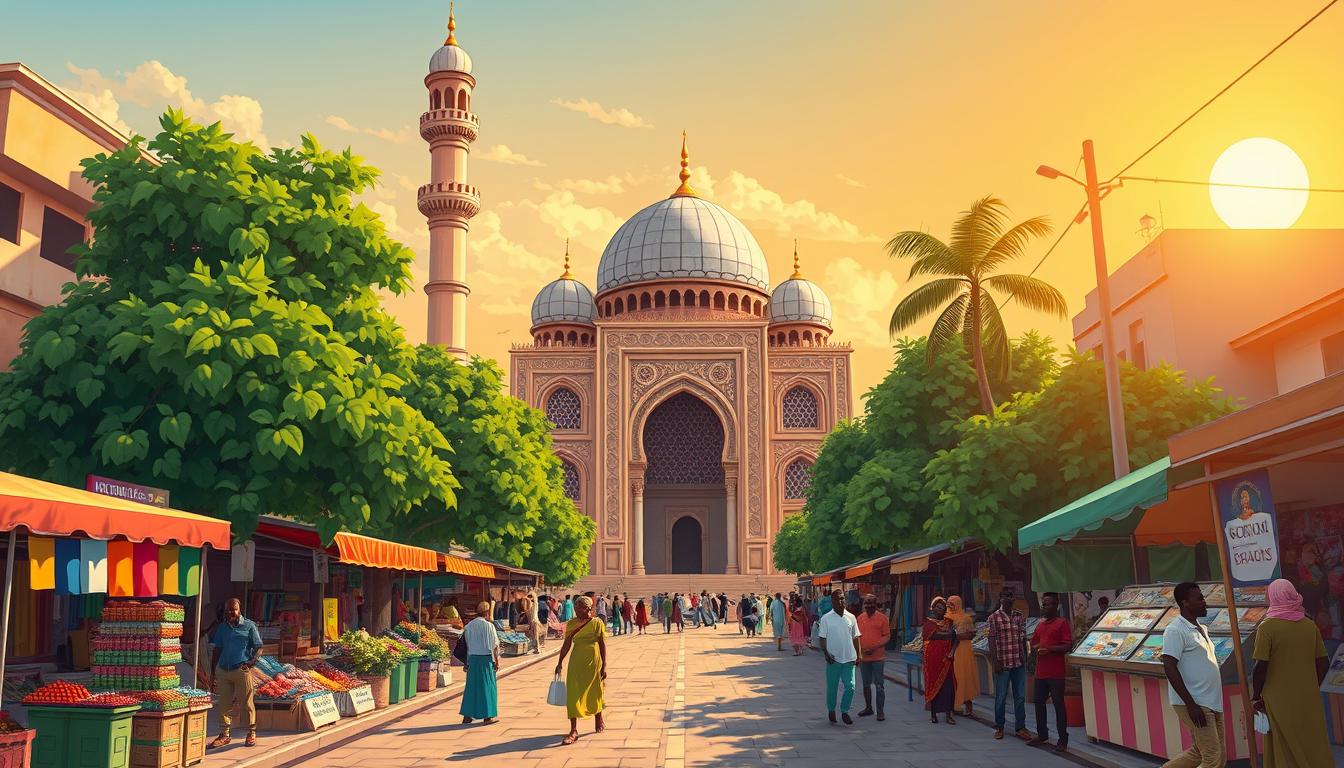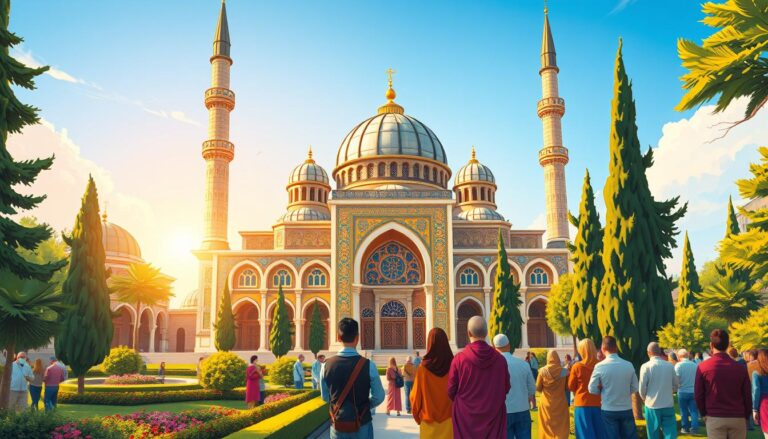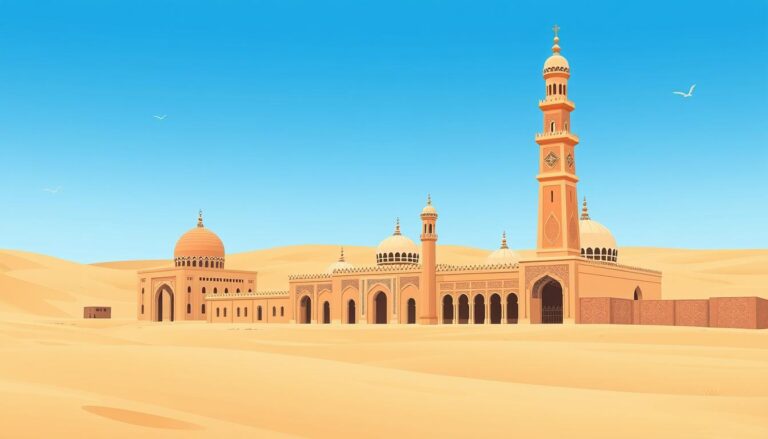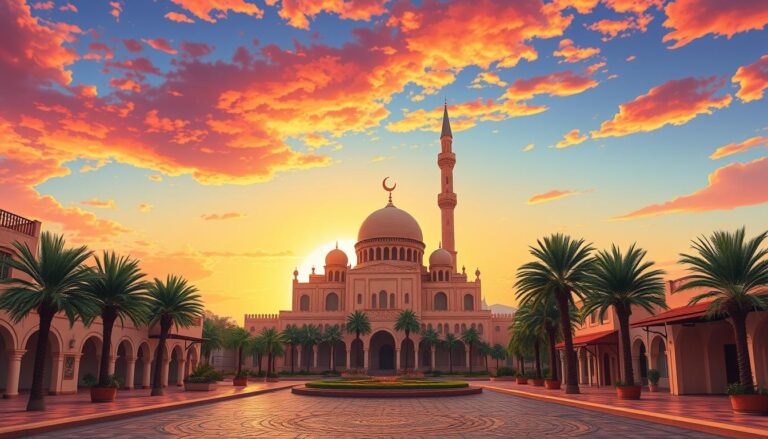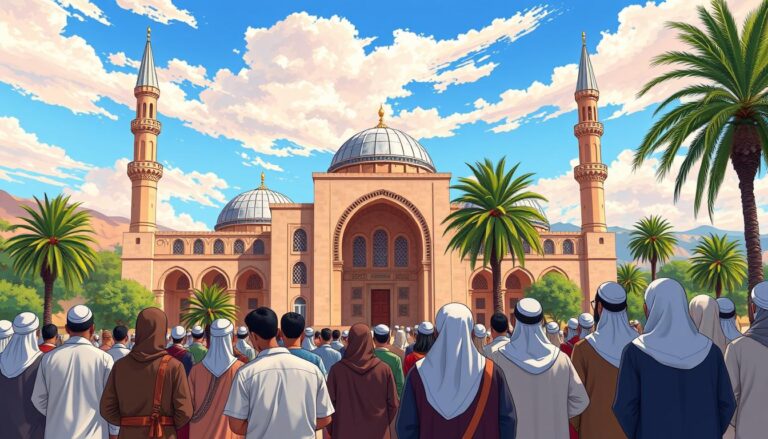Islam in Senegal
Senegal is a vibrant West African nation known for its diverse religious scene. Islam is the main faith, with about 97% of the people following it. For nearly a thousand years, Islam has been a big part of Senegalese life.
The Muslim community in Senegal is rich and varied. It includes many Sufi brotherhoods, like the Tijaniyyah and Muridiyyah (Mourides). These groups add to the unique spiritual and cultural identity of the region.
Islam has a strong hold in Senegal, thanks to its long history and education. Places like the Touba Grand Mosque are centers of learning. They honor figures like Cheikh Ahmadou Bamba, a respected Mouride leader.
This connection to Islam has shaped Senegal’s identity and its society. It has influenced politics and culture too.
Islam: The Predominant Faith in Senegal
In Senegal, Islam is the main religion, with about 97% of people calling themselves Muslim. This faith has a long history, starting with the conversion of King War Jabi in 1040. Over time, Islam spread across Senegal through trade and empires like the Jolof empire, which was slower to adopt Islam.
Statistical Overview of Religious Affiliations
Here’s a breakdown of Senegal’s religious makeup:
- 97.2% of the population are Muslims
- Approximately 6% of the population are Shia Muslims
- Around 2.7% of the population are Christians, mostly in the western and southern regions
Historical Roots and Influence of Islam
Islam has deeply influenced Senegal, shaping its history and culture. In the 17th and 18th centuries, Islam became a powerful force, thanks to Sufi brotherhoods like the Qadiriyyah and Tijaniyyah.
“The spread of Islam in Senegal has been a complex and multifaceted process, shaped by trade, conquest, and the rise of Sufi orders.”
The trans-Saharan trade and the Tukulors and Jolof empire helped spread Islamic beliefs. Today, Islam in Senegal remains a key unifying force, influencing the country’s social, political, and cultural life.
The Sufi Brotherhoods: Pillars of Islamic Tradition
Senegal is a hub for Sufi tradition, with 95% of Muslims joining a Sufi brotherhood. The Tijaniyyah and Muridiyyah (or Mourides) are the biggest orders. The Qadiriyyah and Layene brotherhoods also have a presence in the country.
Tijaniyyah: The Largest Sufi Order
The Tijaniyyah, brought by El Hadj Umar Tall, is the biggest Sufi order in Senegal. It greatly influences the country’s religious and cultural scene. It has a large following across the region.
Mouridiyyah: The Most Influential Brotherhood
The Mourides, started by Cheikh Ahmadou Bamba, are the most influential in Senegal. Their spiritual center is in Touba. This city has one of Africa’s biggest mosques, showing their key role in Islamic tradition.
“The Mouride brotherhood makes up around 40 percent of the total population in Senegal.”
The Sufi brotherhoods are key to Senegal’s Islamic identity. They shape the nation’s religious and cultural landscape with their unique practices and traditions.
Sufism: The Mystical Dimension of Islam in Senegal
Sufism is a key part of Islam in Senegal. Sufi brotherhoods bring unique practices and teachings to the country. They focus on personal devotion and mysticism, shaping the religious identity of many Senegalese Muslims.
Dr. Khadim Mbacké, an Islamic studies researcher, says Sufism is crucial in Senegal. It stands out compared to North Africa and the Middle East. Sufi orders in Senegal blend local beliefs with Islamic teachings, making them popular.
“Sufism has demonstrated a remarkable adaptability over the centuries, initially embracing the ascetic heritage.”
Sufism’s history goes back to the 7th century. It started with a few of the Prophet Muhammad’s Companions who lived simply. By the 9th century, it was known as Sufism, with “Sufi” meaning “wool-wearer.”
Today, Sufi orders like the Tijaniyyah and Mouridiyyah are important in Senegal. They adapt to local customs, keeping their influence strong in a changing society.
Islam in Senegal: A Catalyst for Resistance and Unity
Islam in Senegal became a strong force against French rule. The Mouride movement, a Sufi brotherhood, was key. Many leaders found refuge in these religious groups to resist French control.
Marabouts: Alternative Sources of Authority
The Marabouts, or religious leaders, were highly respected. They guided and supported their communities, countering colonial power. This made them crucial in the fight against French rule.
Amadou Bamba: The Venerated Mouride Leader
Cheikh Amadou Bamba, the Mouride founder, was a major resistance leader. His teachings inspired many, making him a threat to the French. Bamba was arrested twice for his resistance efforts. His followers’ loyalty made Islam a strong unifying force.
“The Mourides became a parallel power structure that challenged the colonial authorities and provided an alternative basis for authority and community organization.”
Islam, especially the Sufi brotherhoods, played a big role in Senegal’s fight against France. It shows Islam’s deep impact on Senegal’s history and society.
Syncretic Traditions: Blending Islam with Local Beliefs
In Senegal, Islam is the main religion, but traditional African beliefs still play a big role. Many Muslims there mix Islamic teachings with their local beliefs. This creates a special form of “African Islam.”
Serer Religion: Preserving Ancient Traditions
The Serer people keep their old religion, A Ƭat Roog. They worship the supreme deity Roog and the Serer pangool (ancestral spirits). Even the baobab tree is important in their traditions. These old beliefs live alongside Islam in Senegal.
“The Serer religion, A Ƭat Roog, is a testament to the resilience of traditional African beliefs in the face of the rising tide of Islam.”
Senegal’s religious practices show its rich culture. Here, old animist traditions and Islam blend together. This mix has shaped the spiritual identity of many Senegalese, making their religious scene vibrant and diverse.
The Serer religion and its Pangool (ancestral spirits) are still strong, even with Islam’s dominance. This balance between old African beliefs and Islam is key to Senegal’s culture.
Islam in Senegal: Generational Shifts and Youth Movements
In recent years, the way Senegalese youth relate to Islam has changed a lot. Many young people still join in big religious events. But, their personal faith and how they see politics have changed.
Some youth now believe in a more open form of Islam. Others want to see religion play a bigger role in public life. This change has led to new youth movements.
The Y’en a Marre (“Fed Up”) movement is one example. It wants to bring Islamic values into politics and society. Groups like Hizbut-Tarqiyyah and Association Musulmane des Etudiants d’Afrique Noire (AMEAN) also show how Islam and Senegalese youth are evolving.
Changing Religiosity Among Senegalese Youth
Senegalese youth’s faith has changed, with some seeing Islam in a more modern way. Others prefer a stricter version. This variety has sparked new movements aiming to influence politics and society.
- The Y’en a Marre movement uses social media and activism to push for change.
- Hizbut-Tarqiyyah and AMEAN focus on Islamic values in schools and politics.
These movements show how Islam and Senegalese youth are adapting to the country’s changing world.
“The youth of Senegal are not just passive recipients of religious traditions, but active agents shaping the future of Islam in their country.”
Islamic Education: Nurturing Knowledge and Spirituality
In Senegal, Islamic education is key to keeping Islam’s rich tradition alive. Quranic schools and religious places are where people study Islamic texts and Sufi practices. Many scholars from Senegal go to Cairo and other Middle Eastern centers of Islamic learning to learn more.
Islamic education is vital for Senegal’s spiritual and intellectual life. Quranic schools teach the basics of Islamic scripture and Sufi mysticism. These schools are important for training the next generation of religious scholars.
“Islamic education emphasizes quality and has been considered a cornerstone of Muslim civilization.”
The value of Islamic education is highlighted by the Islamic Educational, Scientific and Cultural Organization (ISESCO) since 1982. ISESCO aims to enhance education in the Muslim world, seeing it as crucial for knowledge and spirituality.
- Quranic schools serve as hubs for the study of Islamic texts, teachings, and Sufi practices.
- Many Senegalese religious scholars travel to Cairo universities and other Middle Eastern centers of Islamic learning to deepen their knowledge.
- The emphasis on Islamic education is essential for maintaining the spiritual and intellectual vitality of Islam in Senegal.
The mix of Islamic education and Islam’s spiritual essence in Senegal helps preserve the country’s cultural heritage. This approach to learning is key for training the next generation of religious scholars and leaders. They will shape the future of Islamic education in Senegal.
The Diversity of Islamic Practices in Senegal
Senegal, a West African nation, is mostly Muslim. Sunni Islam is the main tradition here. But, the country’s Islamic scene is rich and varied, with many religious practices and groups.
Sunni Islam: The Dominant Tradition
About 97% of Senegal’s Muslims follow Sunni Islam. This tradition deeply influences Senegalese culture and history. It shapes many parts of daily life.
Shia Islam: A Growing Presence
Shia Islam is also present in Senegal, especially among the Lebanese community. Since the 1970s, Shia groups like Mozdahir have been active. They serve the growing Shia population.
Senegal also has a small but active Ahmadiyya Muslim community. However, the mainstream Sunni population sees them as heretical.
“The diversity of Islamic practices in Senegal is a testament to the country’s rich cultural and religious heritage, where various traditions coexist and contribute to the unique fabric of Senegalese society.”
Despite Sunni Islam’s dominance, Senegalese Muslims also follow Sufism. The Tijaniyyah, Muridiyyah, Qadiriyyah, and Layene brotherhoods are key in Islamic life here. This mix of Sufi and local practices has shaped a unique Senegalese Islamic identity.
Islam in Senegal: A Unifying Force for Society
Islam in Senegal brings people together, despite different traditions and practices. Sufi brotherhoods, while each believing in their own path, live in peace. This harmony helps keep Senegal stable and united, with Islam at its heart.
Most Senegalese, 92%, are Muslim. But, 6% follow indigenous beliefs, and 2% are Christian, mostly Catholic. This mix of faiths creates a rich culture, where Islam plays a key role.
The Tijaniyyah and Mouridiyyah Sufi orders shape Senegal’s religious scene. They keep peace, allowing Muslims to explore different Sufi ways. This enriches Senegal’s religious tapestry.
“The religious diversity and harmony in Senegal are a testament to the resilience of the Senegalese people and their commitment to maintaining a peaceful coexistence.”
Islam’s role in Senegal also helps keep the country stable. Despite its challenges, Senegal remains peaceful, thanks to Islam. This makes Senegal a stable example in the region.
In summary, Islam’s role in Senegal is remarkable. It shows how different beliefs can live together, creating a stable society. This is a lesson in celebrating diversity to strengthen a nation.
Conclusion
Senegal’s Islamic heritage is rich and vibrant, shaped by Sufi traditions. This shows Islam’s lasting impact in West Africa. Senegal’s Muslims have mixed their faith with local customs, creating a unique “African Islam.”
The country’s Islamic schools, Sufi brotherhoods, and changing youth attitudes are key to Islam’s growth. This faith remains a strong bond for Senegal.
The Middle Casamance region is crucial for Islam in Senegal and its neighbors. Mandinka Muslim settlements have led in spreading Islam. Centers for Islamic learning were there long before Sufi and jihad movements.
The book “Islam in Senegal” explores how intermarriage, Qur’anic education, and jihad shaped the region. It uses stories from Mandinka Muslims and others like Bainounk and Balante.
Senegal values its diverse religious identity, with Sufi brotherhoods like the Muridiyyah at its heart. Over 80% of Muslims belong to these brotherhoods. Tuba, the Muridiyyah’s holy center, has grown to over 450,000 people.
Islamic schools in Senegal are vital for youth’s religious and intellectual growth. Over half of girls and 60% of boys attend Koranic schools for at least a year.
Source Links
- Islam in Senegal
- Religion in Senegal
- Senegal – United States Department of State
- Islam in Senegal: Maintaining A Delicate Balance
- Jennifer Lang on Islam in Senegal
- Mouride
- Sufism and Religious Brotherhoods in Senegal — Markus Wiener Publishers
- No title found
- From a Neglected to a Crowded Field—The Academic Study of Islam in Sub-Saharan Africa
- Islam in the academic sphere in senegal: the case of Cheikh Anta Diop University in Dakar (UCAD) – Contemporary Islam
- No title found
- The Spread of Islam in West Africa: Containment, Mixing, and Reform from
- Traditional African religions
- Secularity and Freedom of Religion in Senegal: Between a Constitutional Rock and a Hard Reality
- Cautious Democrats: Religious Actors and Democratization Processes in Senegal | Politics and Religion | Cambridge Core
- Negotiating Islam in the Era of Democracy: Senegal in Comparative Regional Perspective
- Providing Much-Needed Education For Africa: An Islamic Approach – Analysis
- The Mouride Brotherhood of Senegal: A Muslim Community
- Education, Embodiment, and Epistemology
- Tolerance and Tension: Islam and Christianity in Sub-Saharan Africa
- No title found
- Senegal: Muslim country profile
- The Institutionalization of Islam in Southern Senegal
- Conclusion

